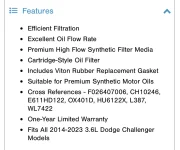As already mentioned, an oil filter is a small part of the total resistance created by the oiling system, and is typically only about 1/15th as flow restrictive as the typical oiling system. The only time an oil filter could reduce oil from from the positive displacement pump is if the filter is so restrictive that it makes the pump hit pressure relief - it would essentially need to be close to 100% clogged and have a tiny bypass valve opening on top of that. If the pump is not in pressure relief, then what leaves the pump goes through the filter and oiling system, regardless of how restrictive they are.The k&n oil filter is high flow. The efficiency is passable but not a selling point.
It's a long standing misconception that "better flowing" oil filters give more oil volume to the system, but 99% of the time that doesn't happen because the oil pump never hits pressure relief. People equate an oil filter flow restriction to something like the water system in their house, where an in-line filter would "choke down" the flow as it becomes more restrictive. The correct way to think about oil filter flow restriction is a filter with lower restriction means the delta-p across the media is lower vs flow going through the filter. PD oil pumps are "pure magic", and used for some good reasons on oiling systems.

